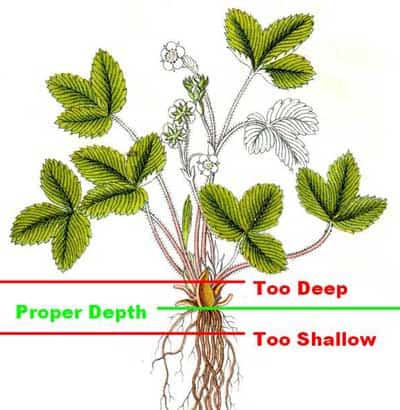 The strawberry, or old Anglo-Saxon word “streowberie”, could have been named as a result of the old practice of laying straw around cultivated plants to keep the fruit off the ground, or as a way to describe how the plants are ‘strewn’ across the ground. Either way, this delicious berry is native to Canada and its native varieties produce small but flavourful berries.
The strawberry, or old Anglo-Saxon word “streowberie”, could have been named as a result of the old practice of laying straw around cultivated plants to keep the fruit off the ground, or as a way to describe how the plants are ‘strewn’ across the ground. Either way, this delicious berry is native to Canada and its native varieties produce small but flavourful berries.
Plant Care:
To maximize berry production, strawberries prefer well drained soil that is high in organic matter. If your soil is heavy and clay like, you will want to till the soil and incorporate organic matter. Strawberries also prefer an area that receives full sun and a soil pH around 6-6.5.
There are 3 types of strawberries to be aware of:
June-bearing: Produce one crop per year around June or July
Everbearers: Produce two crops, on in June/July, and the other in the fall
Day-neutrals: Produce fruits continuously through the growing season
*Crop size and yield on everbearers and day-neutrals tend to be lower than june bearers.
 Strawberries are considered herbaceous perennials and generally live up to 4-5 years. For pest control reasons, it is best to move your strawberry patch every 4 years and ensure that the same area doesn't have strawberries for at least 4 years. As with many fruit bearing plants, it is best to remove all blossoms in the first year of planting (get rid of all potential fruit) in order to focus the plant’s energy on root growth and development. In this way, you will get a stronger plant that will produce higher yields. Everbearers and day-neutrals should have their blossoms taken off in the first harvest season.
Strawberries are considered herbaceous perennials and generally live up to 4-5 years. For pest control reasons, it is best to move your strawberry patch every 4 years and ensure that the same area doesn't have strawberries for at least 4 years. As with many fruit bearing plants, it is best to remove all blossoms in the first year of planting (get rid of all potential fruit) in order to focus the plant’s energy on root growth and development. In this way, you will get a stronger plant that will produce higher yields. Everbearers and day-neutrals should have their blossoms taken off in the first harvest season. Because strawberries reproduce by sending out runners, it is best to leave rows about 5 to 6 feet apart. This will allow the runners to fill in the space and keep your strawberry patch vigorous and productive.
Because strawberries reproduce by sending out runners, it is best to leave rows about 5 to 6 feet apart. This will allow the runners to fill in the space and keep your strawberry patch vigorous and productive.
As a result of a shallow root system, mulch and watering are crucial for the summer, when roots need to be hydrated.
A complete organic fertilizer can be applied in the spring to promote berry growth. About 1.5 pounds per 10 foot row.
Interesting Notes:
- Although mostly enjoyed fresh, strawberry leaf tea can also be made and used as a vitamin C supplement.
- Large amounts of strawberry fruit in the diet is said to slow dental plaque formation.

No comments:
Post a Comment